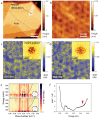Strain Effects in Twisted Spiral Antimonene
- PMID: 37092560
- PMCID: PMC10323604
- DOI: 10.1002/advs.202301326
Strain Effects in Twisted Spiral Antimonene
Abstract
Van der Waals (vdW) layered materials exhibit fruitful novel physical properties. The energy band of such materials depends strongly on their structures, and a tremendous variation in their physical properties can be deduced from a tiny change in inter-layer spacing, twist angle, or in-plane strain. In this work, a kind of vdW layered material of spiral antimonene is constructed, and the strain effects in the material are studied. The spiral antimonene is grown on a germanium (Ge) substrate and is induced by a helical dislocation penetrating through few atomic-layers of antimonene (β-phase). The as-grown spiral is intrinsically strained, and the lattice distortion is found to be pinned around the dislocation. Both spontaneous inter-layer twist and in-plane anisotropic strain are observed in scanning tunneling microscope (STM) measurements. The strain in the spiral antimonene can be significantly modified by STM tip interaction, leading to a variation in the surface electronic density of states (DOS) and a large modification in the work function of up to a few hundreds of millielectron-volts (meV). Those strain effects are expected to have potential applications in building up novel piezoelectric devices.
Keywords: Antimonene; helical dislocation; spiral; strain effect; vdW layered material.
© 2023 The Authors. Advanced Science published by Wiley-VCH GmbH.
Conflict of interest statement
The authors declare no conflict of interest.
Figures




References
-
- Cao Y., Fatemi V., Fang S., Watanabe K., Taniguchi T., Kaxiras E., Jarillo‐Herrero P., Nature 2018, 556, 43. - PubMed
-
- Serlin M., Tschirhart C. L., Polshyn H., Zhang Y., Zhu J., Watanabe K., Taniguchi T., Balents L., Young A. F., Science 2019, 367, 900. - PubMed
-
- Cao Y., Rodan‐Legrain D., Park J. M., Yuan N. F. Q., Watanabe K., Taniguchi T., Fernandes R. M., Fu L., Jarillo‐Herrero P., Science 2021, 372, 264. - PubMed
-
- Carr S., Fang S., Jarillo‐Herrero P., Kaxiras E., Phys. Rev. B 2018, 98, 085144.
-
- Yankowitz M., Chen S., Polshyn H., Zhang Y., Watanabe K., Taniguchi T., Graf D., Young A. F., Dean C. R., Science 2019, 363, 1059. - PubMed
Grants and funding
LinkOut - more resources
Full Text Sources
